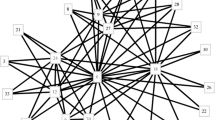Abstract
In this paper, we first show that every (\(P_6\), diamond, \(K_4\))-free graph is 6-colorable. We also give an example of a (\(P_6\), diamond, \(K_4\))-free graph G with \(\chi (G)\) \( = 6\). Further, we show that for every (\(P_6\), diamond)-free graph G, the chromatic number of G is upper bounded by a linear function of its clique number. This generalizes some known results in the literature.


Similar content being viewed by others
References
Addario-Berry, L., Chudnovsky, M., Havet, F., Reed, B., Seymour, P.: Bisimplicial vertices in even-hole-free graphs. J. Combin. Theory Ser. B 98, 1119–1164 (2008)
Bharathi, A.P., Choudum, S.A.: Colouring of \(P_2\cup P_3\)-free graphs. Graphs Combin. 34(1), 97–107 (2018)
Blanche, A., Dabrowski, K. K., Johnson, M., Paulusma, D.: Hereditary graph Classes: when the complexities of colouring and clique cover coincide. arXiv:1607.06757v3 (2017)
Brandstädt, A., Giakoumakis, V., Maffray, F.: Clique separator decomposition of hole-free and diamond-free graphs and algorithmic consequences. Disc. Appl. Math. 160, 471–478 (2012)
Brandt, S.: Triangle-free graphs and forbidden subgraphs. Disc. Appl. Math. 120, 25–33 (2002)
Broersma, H.J., Golovach, P.A., Paulusma, D., Song, J.: Updating the complexity status of coloring graphs without a fixed induced linear forest. Theoret. Comput. Sci. 414, 9–19 (2012)
Choudum, S.A., Karthick, T.: Maximal cliques in \(P_2 \cup P_3, C_4\)-free graphs. Disc. Math. 310, 3398–3403 (2010)
Choudum, S.A., Karthick, T., Shalu, M.A.: Perfect coloring and linearly \(\chi \)-bound \(P_6\)-free graphs. J. Graph Theory 54(4), 293–306 (2007)
Chudnovsky, M., Goedgebeur, J., Schaudt, O., Zhong, M.: Obstructions for three-coloring graphs without induced paths on six vertices. Proc. SODA 2016, 1774–1783 (2016)
Chudnovsky, M., Seymour, P., Robertson, N., Thomas, R.: The strong perfect graph theorem. Ann. Math. 164(1), 51–229 (2006)
Chudnovsky, M., Seymour, P., Robertson, N., Thomas, R.: \(K_4\)-free graphs with no odd holes. J. Combin. Theory Ser. B 100, 313–331 (2010)
Chudnovsky, M., Spirkl, S., Zhong, M.: Four-coloring \(P_6\)-free graphs. I. Extending an excellent precoloring, arXiv:1802.02282v2 [math.CO] (2018)
Chudnovsky, M., Spirkl, S., Zhong, M.: Four-coloring \(P_6\)-free graphs. II. Finding an excellent precoloring, arXiv:1802.02283v2 [math.CO] (2018)
Dabrowski, K. K., Dross, F., Paulusma, D.: Colouring diamond-free graphs. In: 15th Scandinavian Symposium and Workshops on Algorithm Theory (SWAT 2016), Rasmus Pagh Ed., LIPICS, Article No. 16; pp. 16:1–16:14
Esperet, L., Lemoine, L., Maffray, F., Morel, M.: The chromatic number of \(P_5, K_4\)-free graphs. Disc. Math. 313, 743–754 (2013)
Fan, G., Xu, B., Ye, T., Yu, X.: Forbidden subgraphs and \(3\)-colorings. SIAM J. Disc. Math. 28, 1226–1256 (2014)
Golovach, P.A., Johnson, M., Paulusma, D., Song, J.: A survey on the computational complexity of colouring graphs with forbidden subgraphs. J. Graph Theory 84, 331–363 (2017)
Golumbic, M.C.: Algorithmic Graph Theory and Perfect Graphs, Annals of Discrete Mathematics, 2nd edn. Elsevier, Amsterdam (2004)
Gravier, S., Hoàng, C.T., Maffray, F.: Coloring the hypergraph of maximal cliques of a graph with no long path. Disc. Math. 272, 285–290 (2003)
Gyárfás, A.: Problems from the world surrounding perfect graphs. Zastosowania Matematyki Applicationes Mathematicae 19, 413–441 (1987)
Huang, S.: Improved complexity results on \(k\)-coloring \(P_t\)-free graphs. Eur. J. Combin. 51, 336–346 (2016)
Karp, R.M.: Reducibility among combinatorial problems. In: Miller, R.E., Thatcher, J.W., editors, Complexity of computer computations. Plenum, New York, pp. 85–103 (1972)
Karthick, T.: Vertex coloring and cliques of certain \(P_6\)-free graphs and claw-free graphs. Ph.D. Thesis, IIT Madras (2010)
Karthick, T., Maffray, F.: Vizing bound for the chromatic number on some graph classes. Graphs Combin. 32, 1447–1460 (2016)
Kloks, T., Müller, H., Vušković, K.: Even-hole-free graphs that do not contain diamonds: a structure theorem and its consequences. J. Combin. Theory. Ser. B 99, 733–800 (2009)
Kral, D., Kratochvil, J., Tuza, Z.S., Woeginger, G.J.: Complexity of coloring graphs without forbidden induced subgraphs. In: Proceedings of WG 2001, Lecture Notes in Computer Science 2204, 254–262 (2001)
Mosca, R.: Independent sets in (\(P_6\), diamond)-free graphs. Disc. Math. Theoret. Comput. Sci. 11, 125–140 (2009)
Mycielski, J.: Sur le coloriage des graphes. Colloq. Math. 3, 161–162 (1955)
Pyatkin, A.V.: Triangle-free \(2P_3\)-free graphs are \(4\)-colorable. Disc. Math. 313, 715–720 (2013)
Randerath, B., Schiermeyer, I.: \(3\)-colorability \(\in \cal{P}\) for \(P_6\)-free graphs. Disc. Appl. Math. 136, 299–313 (2004)
Randerath, B., Schiermeyer, I.: Vertex colouring and forbidden subgraphs: a survey. Graphs Combin. 20, 1–40 (2004)
Randerath, B., Schiermeyer, I., Tewes, M.: Three-colourability and forbidden subgraphs. II: polynomial algorithms. Disc. Math. 251, 137–153 (2002)
Tucker, A.: Coloring perfect \((K_4 -e)\)-free graphs. J. Combin. Theory Ser. B 42, 313–318 (1987)
West, D.B.: Introduction to Graph Theory, 2nd edn. Prentice-Hall, Englewood Cliffs, New Jersey (2000)
Acknowledgements
The first author thanks Mathew C.Francis for his comments. The authors are grateful to the anonymous referees for their helpful suggestions and remarks.
Author information
Authors and Affiliations
Corresponding author
Rights and permissions
About this article
Cite this article
Karthick, T., Mishra, S. On the Chromatic Number of (\(P_6\), Diamond)-Free Graphs. Graphs and Combinatorics 34, 677–692 (2018). https://doi.org/10.1007/s00373-018-1905-9
Received:
Revised:
Published:
Issue Date:
DOI: https://doi.org/10.1007/s00373-018-1905-9




